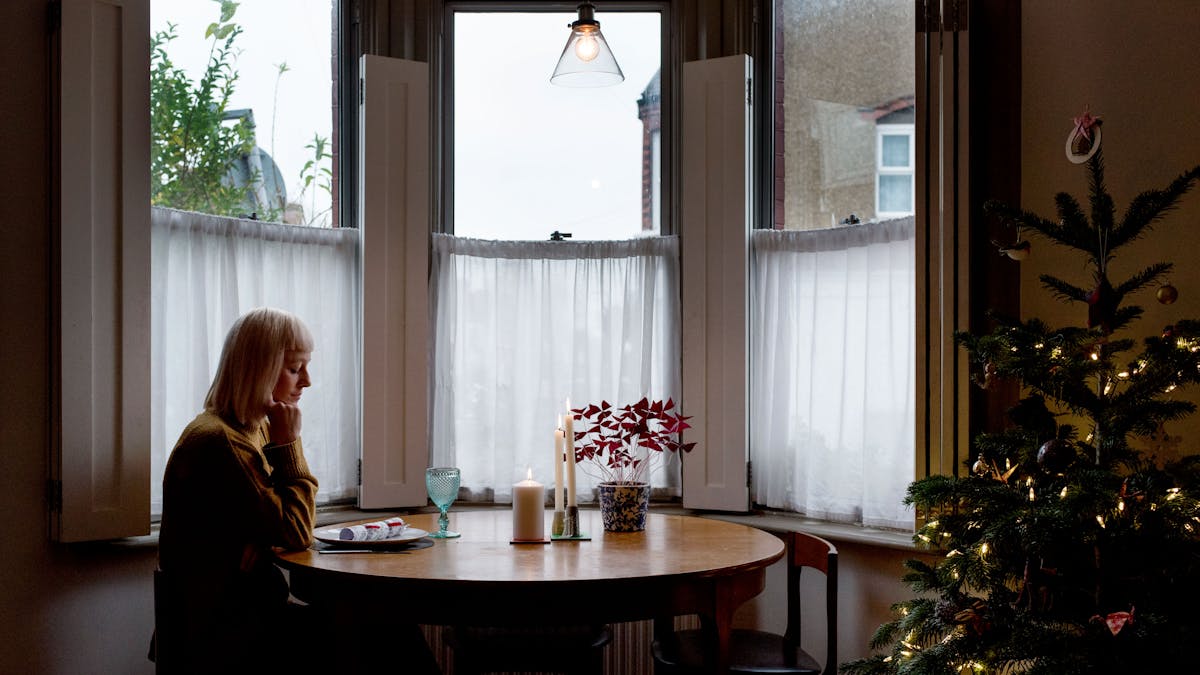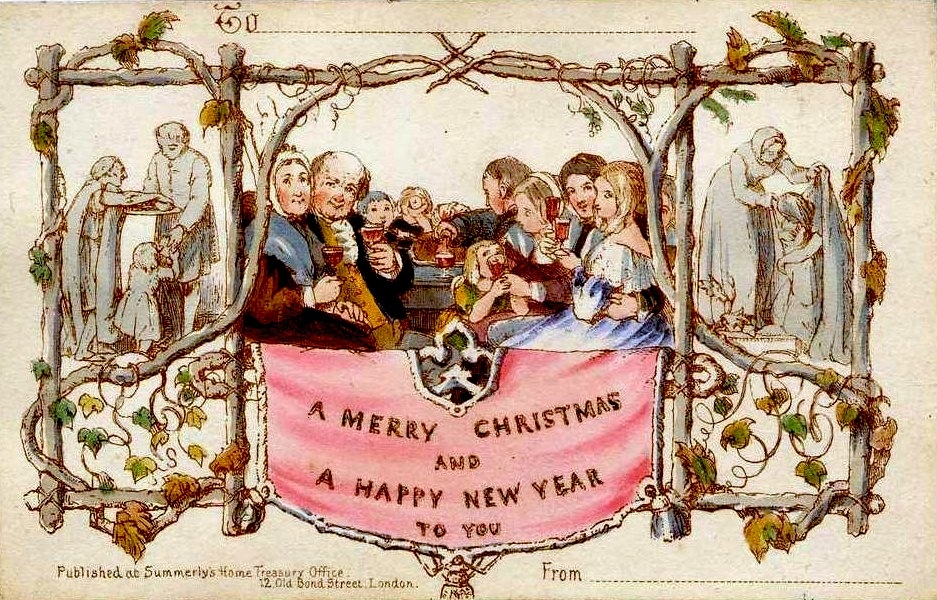In many ways, loneliness is a kind of hunger – for feeling included, needed and cared for. Historian Fay Bound Alberti explores how Christmas food and traditions connect us to history and our community, and reflects on those who feel isolated, especially at this time of year.
Lonely bodies are hungry for more than turkey
Words by Dr Fay Bound Albertiaverage reading time 7 minutes
- Article

Amidst an apparent ‘epidemic of loneliness’, UK charities and businesses are pledging to support those who are lonely at Christmas. The Alexandria Public House in Wimbledon announced a “FREE turkey dinner & a pint on Christmas Day for anyone who is on their own”, and will do the same in 2018. Believing “no one should be alone at Christmas”, a Pendle charity has similarly set up an “inclusive Christmas dinner” for anyone in need. And the homeless charity Crisis provides a range of advice and facilities, including a Christmas dinner for a homeless person, when someone donates just under £30.
Such offerings are a welcome reminder that Christmas is regarded as a season of goodwill and bonhomie. Though loneliness is not just for Christmas – it arises at different times, for many different reasons. And there are various types. The loneliness of a homeless person vulnerable on the streets or existing without medical care will be different from that of an elderly person in good accommodation but recently bereaved. And not everyone minds being alone, or even lonely, at Christmas time.
When I was a child, my dad often announced he would rather be alone. “Bah, humbug,” we told him. Because didn’t everyone want to feel part of the festive celebrations? Not so. For some people, solitude is more enjoyable than sociability, even at Christmas. And it’s common to feel lonely in a crowd. The pressure to be with other people during the festive season – alongside the pressures to spend, to see family, to celebrate – can even produce loneliness.
The image of the ideal Christmas
The Christmas dinner, then, is a symbol of togetherness but also alienation. And it’s a surprisingly recent invention. It was not until 1848, when the Illustrated London News published an image of the British monarchy around a decorated Christmas tree (a custom imported from Prince Albert’s German childhood), that the UK embraced Christmas decorations. This was part of a widespread move in the UK towards celebrating Christmas in distinctively modern ways.
MORE: How storytelling helped writer JJ Bola understand his displacement
In 1843, the inventor Henry Cole published the country’s first commercial Christmas card, which depicted a large family gathering seated around a table and flushed with wine, while the remains of a roast are visible. To the left of this coloured image, a poorer, smaller group break bread; to the right, a Madonna-like woman and child are physically and metaphorically clothed, or so it seems, by Christian charity. Costing a shilling each, these cards would not have been within the reach of many ordinary people, but like the Christmas trees, Christmas crackers, gifts and home decorations, the Christmas dinner became part of an idealised Christmas.
The world's first commercially produced Christmas card, designed by John Callcott Horsley for Henry Cole in 1843.
Like all festive food, Christmas dinner means more than its parts. The ceremonials around the preparation and eating of the feast – from peeling sprouts to carving the bird, from stirring the coin into the pudding to drenching fruitcake in brandy – are physical acts that are rooted in tradition. Each member of the household might have a role in those processes, whether it’s laying the table or passing down a specific recipe (my own favourite being sprouts à la barigoule, without which Christmas isn’t complete).
Food, as a way to celebrate identity, belonging, memory and place is central to celebrations around the globe. In Japan, it’s customary to eat fried chicken on Christmas Eve, an invented tradition that helped KFC get a foothold in the country. Consider the importance of latkes for Jewish people, tamales in Costa Rica, kūčios in Lithuania and the baida roti of Eid Mubarak.
Most people have a physical as well as a psychological association with a particular food, whatever the culture being celebrated. Food has enormous emotional significance because it links people with the past, the present and the future; it creates a framework of belonging and resilience and it provides an antidote to loneliness.
For those who do feel lonely at Christmas then, especially when loneliness intersects with old age and social isolation, homelessness or illness, food is an important reminder of rootedness to a longer tradition, custom or sense of community. It reminds people where they might (or might not) belong. While the table groaning with the weight of turkey, trifle, puddings and dates might symbolise togetherness, its absence promotes the sense of hunger and lack felt by those who are socially as well as physically starving.
The language of loneliness
The charity in Pendle emphasises that their Christmas dinner will provide ‘warmth’ and comfort to those it welcomes. Crisis offers not only a hot meal but a warm shower alongside medical care. These languages of bodily warmth and fullness, alongside tending to the whole body, is important; people who are lonely talk in terms of physical as well as emotional coldness and lack. The hungry body becomes a powerful metaphor for loneliness, as the social neuroscientist John Cacioppo observed.
For Cacioppo, who sadly passed away in 2018, loneliness was “a bit like pain, hunger and thirst”. Loneliness, like pain, was as physical sign of impending danger. For the individual without social networks, that danger came from social isolation – lethal for our tribal ancestors; dangerous in different ways today, as lonely people get ill more often, die earlier, and experience depression and disease.
The lonely body is a hungry body in multiple ways; loneliness makes people more prone to eating, and overeating, in order to fill that perceived lack. By contrast with the language of loneliness, which emphasises coldness and hunger – couched in phrases like “being out in the cold”, or “getting the cold shoulder” – the ‘warm heart’ of a companionable person brings emotional and well as physical comfort.
All emotional experience is physical; it does not live entirely in the mind.
Bringing people together for a Christmas dinner is a kind and generous act, but it can also be a reminder of the broader disconnect of a lonely life; the everyday lack of sensory stimulation that ranges from a sense of touch – sexual and sensual as well as restorative – or the sound of a loved one’s voice, the scent of their perfume, the taste of home-cooked food.
When I think back on Christmases past, my memories focus on its physical reminders: the heat of the fire, the rustle of the wrapping paper; the taste of the trifle; the scent of new toiletries and spent Christmas crackers; the feel of the paper hat too tight or too loose; the clink of the cutlery and the familiar voices of people laughing, arguing, shouting or singing. I grew up in Wales, where my Christmases were also linked to the deep bass of Welsh choirs and the dusty smell of church prayer cushions.
If you reflect on your own memories of festive events, I am sure you will have your own particular register of moments when you felt part of something bigger or entirely alone; when that togetherness felt warm or suffocating, and when isolation made you feel cold and exposed.
All emotional experience is physical; it does not live entirely in the mind. Lonely bodies are hungry for more than turkey; if they are lonely, they are hungry, too, for the connections and memories linked to that turkey: to the feeling of being cared for and needed and included. In all these ways, the physical, lived experience of loneliness needs to be tended to, at Christmas as well as all year round.
About the author
Dr Fay Bound Alberti
Fay Bound Alberti is a writer, historian and consultant focusing on health, gender, emotions and the body – in history and in the present. She co-founded the Centre for the History of Emotions at Queen Mary University of London, where she is an Honorary Senior Research Fellow, and her books include 'This Mortal Coil: The Human Body in History and Culture'.

